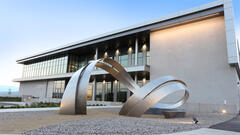
What is Mammography?
Each year, about 175,000 new cases of breast cancer — and 43,000 deaths from it — are reported in the United States. Breast cancer is the second leading cause of cancer death in women of any age, and the leading cause in women between 40 and 50, yet breast cancer is curable. The key to successful treatment is early detection, and mammography is a safe, effective, and affordable method for the detection of cancers as small as a half of a millimeter.
Imaging of the breast is difficult because breast tissues are all so similar. A radiograph of the hand, for example, demonstrates the bones of the hand dramatically, but the soft tissue around the bones, which is comprised of skin, fat, muscle, and so on, show as gray shadows, indistinguishable from one another.
The mammogram shown here demonstrates the detail within the breast tissue that can be obtained when proper technique is used. It also shows the position of a biopsy needle, which is used to extract suspect tissue for microscopic examination.
Breast tissue, like the soft tissue of the hand, will have no detail unless the best equipment is used, the best technique is practiced, and the quality of the films produced are monitored vigorously.
Mammography is a quick, and relatively easy examination to perform, and yet it is a specialty of radiologic science with its own advanced registry examination. The reason is the skill required for the technique, and the careful attention to detail that must be practiced to make this examination valuable. Equally important is the rigorous quality testing which is required for optimal results.

The picture on the left is a dedicated mammography unit.
The picture on the right is a stereotactic breast biopsy machine, which is used to accurately position a biopsy needle, as a replacement to a surgical biopsy.






